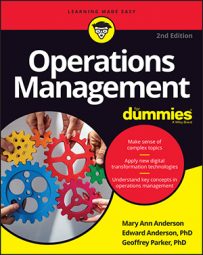Processes vary in thousands of ways for different kinds of organizations with different kinds of operational needs. Start-up firms need to scale up rapidly, and the restaurant business requires some artistry. Pharmaceutical companies must stay focused on strict regulations, and firms in the personal computer industry must worry about shelf life. To manage operations effectively, you need to understand a company’s processes in context of its business model and industry.
Here are some important characteristics of organizations that can help illustrate the nature of certain processes.
Customer interface
Processes vary quite a bit based on the amount of face time with customers they involve. Service processes that don’t directly interface with customers, such as reconciling checks, are more like manufacturing processes than processes that involve interaction with customers. After all, reconciled checks, don’t become upset if the resource processing them doesn’t smile. Nor do they get confused by poor signage, waiting in line, or bad process design.
The customer interface aspect of operations also differs based on whether the customer is the end consumer, known as a B2C relationship, or another business, or B2B relationship:
B2C firms tend to market products to a lot of customers who each purchase a small quantity of units.
B2B firms tend to deal with a small number of customers with high quantity demands that require heavy customization and significant customer service.
In general, business customers are much less forgiving of late deliveries than end consumers.
Scale
The scale of an operation definitely impacts operations. Producing thousands of parts or serving thousands of customers per hour is quite different from handling only a few. If a company is working by the thousands, then automation may make a lot of sense because the fixed costs of automation can be spread out over many customers. A low-volume operation typically requires more flexible processes, which may rule out automation.
Customization
If a company’s product or service is highly customized, then flexibility in processes is extremely important. Automation may not be practical.
Producing products before a customer places an order is also impractical in many of these situations, and this may prevent a business from obtaining economies of scale, which refers to the fact that it becomes increasingly cheaper to produce a unit of something as unit volume grows. Customizing products usually means higher production costs per unit and higher prices for customers.
Customer priorities
Successful businesses know what matters most to their target customers: time, cost, or quality. If time is most important, you may try to produce the product before the customer orders it. If cost is the priority, maximizing economies of scale — possibly through level production runs or outsourcing — is critical. An emphasis on quality may require more expensive materials and equipment to make the product.

